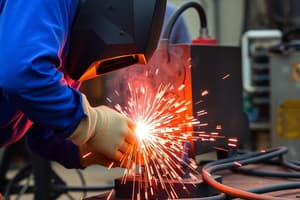Podcast
Questions and Answers
What is the primary mechanism by which fusion welding joins materials?
What is the primary mechanism by which fusion welding joins materials?
- Mechanical friction
- Pressure application
- Chemical bonding
- Heat application (correct)
Which type of welding does NOT typically require filler materials?
Which type of welding does NOT typically require filler materials?
- Electron beam welding
- Fracture welding
- Arc welding
- Friction welding (correct)
Which welding technique is known for its versatility in joining various metals including stainless steel and titanium?
Which welding technique is known for its versatility in joining various metals including stainless steel and titanium?
- Laser welding
- Friction welding
- Electron beam welding
- Arc welding (correct)
How does friction welding generate the heat necessary for bonding materials?
How does friction welding generate the heat necessary for bonding materials?
What advantage does laser welding provide over traditional welding methods?
What advantage does laser welding provide over traditional welding methods?
Which characteristic is NOT associated with electron beam welding?
Which characteristic is NOT associated with electron beam welding?
Which welded joint type is characterized by two pieces being joined at their edge, without interpenetrating?
Which welded joint type is characterized by two pieces being joined at their edge, without interpenetrating?
Which gases are primarily used in MIG welding to provide shielding?
Which gases are primarily used in MIG welding to provide shielding?
What is one key advantage of using the MIG/MAG welding processes?
What is one key advantage of using the MIG/MAG welding processes?
What is a characteristic of the active gas mixtures used in MAG welding?
What is a characteristic of the active gas mixtures used in MAG welding?
Which of the following is a disadvantage of MIG/MAG welding?
Which of the following is a disadvantage of MIG/MAG welding?
In the MIG welding process, what happens to the weld pool visibility compared to other welding processes?
In the MIG welding process, what happens to the weld pool visibility compared to other welding processes?
What is a primary characteristic of electron beam welding (EBW)?
What is a primary characteristic of electron beam welding (EBW)?
Which of the following statements about laser beam welding is accurate?
Which of the following statements about laser beam welding is accurate?
What distinguishes resistance spot welding from resistance seam welding?
What distinguishes resistance spot welding from resistance seam welding?
What is the heat affected zone (HAZ) in welding?
What is the heat affected zone (HAZ) in welding?
How does electron beam welding (EBW) differ from laser beam welding?
How does electron beam welding (EBW) differ from laser beam welding?
Which welding technique is best suited for minimizing heat distortion?
Which welding technique is best suited for minimizing heat distortion?
What is a potential disadvantage of using electron beam welding?
What is a potential disadvantage of using electron beam welding?
In which scenario would resistance seam welding be more advantageous than resistance spot welding?
In which scenario would resistance seam welding be more advantageous than resistance spot welding?
Why is the heat affected zone (HAZ) significant in welding?
Why is the heat affected zone (HAZ) significant in welding?
What is another name for Shielded Metal Arc Welding (SMAW)?
What is another name for Shielded Metal Arc Welding (SMAW)?
Which of the following is an advantage of using SMAW?
Which of the following is an advantage of using SMAW?
What is a common disadvantage of SMAW?
What is a common disadvantage of SMAW?
Which statement about SMAW is true?
Which statement about SMAW is true?
Which technique uses an electrode that can be bent easily?
Which technique uses an electrode that can be bent easily?
What is a factor that typically reduces the production efficiency in SMAW?
What is a factor that typically reduces the production efficiency in SMAW?
Which of the following materials can be welded using SMAW?
Which of the following materials can be welded using SMAW?
Why is SMAW considered advantageous for outdoor welding?
Why is SMAW considered advantageous for outdoor welding?
Which of the following best describes the deposition rate of SMAW?
Which of the following best describes the deposition rate of SMAW?
What is a limitation of using SMAW in terms of welding productivity?
What is a limitation of using SMAW in terms of welding productivity?
What is the primary issue caused by inclusion in a weld?
What is the primary issue caused by inclusion in a weld?
What can contribute to the inclusion defect in welding?
What can contribute to the inclusion defect in welding?
Which of the following is NOT a remedy for inclusion in welding?
Which of the following is NOT a remedy for inclusion in welding?
Why are weld cracks considered the most serious type of welding defect?
Why are weld cracks considered the most serious type of welding defect?
What typically characterizes cold cracks in welding?
What typically characterizes cold cracks in welding?
Which factor is NOT typically associated with the occurrence of cracks in welding?
Which factor is NOT typically associated with the occurrence of cracks in welding?
What is a recommended practice to prevent inclusion during multi-pass welding?
What is a recommended practice to prevent inclusion during multi-pass welding?
What happens to the metal structure when cold cracks occur?
What happens to the metal structure when cold cracks occur?
What’s one way to redesign a joint to minimize the risk of inclusion?
What’s one way to redesign a joint to minimize the risk of inclusion?
Flashcards
Inclusion in welds
Inclusion in welds
A type of welding defect that can occur in the weld metal or the heat-affected zone. It is caused by foreign materials becoming trapped within the weld.
Weld cracks
Weld cracks
A serious welding defect that can occur on the surface, within the weld metal, or in the heat-affected zone. It can occur at various temperatures.
Cold crack
Cold crack
A type of crack that happens after the weld has cooled down and can form hours or even days later. It's common in steel welds and often linked to structural deformities.
What is welding?
What is welding?
Signup and view all the flashcards
What is fusion welding?
What is fusion welding?
Signup and view all the flashcards
What is the anatomy of a weld?
What is the anatomy of a weld?
Signup and view all the flashcards
What are welding positions?
What are welding positions?
Signup and view all the flashcards
What is arc welding?
What is arc welding?
Signup and view all the flashcards
What is friction welding?
What is friction welding?
Signup and view all the flashcards
What is electron beam welding?
What is electron beam welding?
Signup and view all the flashcards
Electron Beam Welding (EBW)
Electron Beam Welding (EBW)
Signup and view all the flashcards
Why is EBW performed in a vacuum?
Why is EBW performed in a vacuum?
Signup and view all the flashcards
Laser Welding
Laser Welding
Signup and view all the flashcards
Can laser welding be performed in air?
Can laser welding be performed in air?
Signup and view all the flashcards
Resistance Welding
Resistance Welding
Signup and view all the flashcards
Resistance Spot Welding
Resistance Spot Welding
Signup and view all the flashcards
Resistance Seam Welding
Resistance Seam Welding
Signup and view all the flashcards
Heat Affected Zone (HAZ)
Heat Affected Zone (HAZ)
Signup and view all the flashcards
Why does the HAZ have altered properties?
Why does the HAZ have altered properties?
Signup and view all the flashcards
MIG/MAG Welding
MIG/MAG Welding
Signup and view all the flashcards
MIG Welding (Metal Inert Gas)
MIG Welding (Metal Inert Gas)
Signup and view all the flashcards
MAG Welding (Metal Active Gas)
MAG Welding (Metal Active Gas)
Signup and view all the flashcards
Advantages of MIG/MAG Welding
Advantages of MIG/MAG Welding
Signup and view all the flashcards
Disadvantages of MIG/MAG Welding
Disadvantages of MIG/MAG Welding
Signup and view all the flashcards
Shielded Metal Arc Welding (SMAW)
Shielded Metal Arc Welding (SMAW)
Signup and view all the flashcards
Flux in SMAW
Flux in SMAW
Signup and view all the flashcards
Versatility of SMAW
Versatility of SMAW
Signup and view all the flashcards
Advantages of SMAW
Advantages of SMAW
Signup and view all the flashcards
Gas-independent nature of SMAW
Gas-independent nature of SMAW
Signup and view all the flashcards
SMAW for tight spaces
SMAW for tight spaces
Signup and view all the flashcards
Deposition rate in SMAW
Deposition rate in SMAW
Signup and view all the flashcards
Filler metal cost in SMAW
Filler metal cost in SMAW
Signup and view all the flashcards
Production factor in SMAW
Production factor in SMAW
Signup and view all the flashcards
Overall advantages of SMAW
Overall advantages of SMAW
Signup and view all the flashcards
Study Notes
Advanced Joining Processes - Welding Processes
- Welding is a fabrication process where two or more parts are joined together by heat, pressure, or both, as the parts cool.
- Fusion welding uses heat to join or fuse two or more materials to their melting point. It may or may not require a filler material.
- First documented use of fusion welding was in 1881 by Auguste de Meritens, who used carbon electrodes to weld lead battery plates.
- Welding joints can have varied geometries and can be carried out in different positions of varying difficulty (e.g., flat, horizontal, vertical, overhead).
Basics of Welding
- Introduction: Welding is a fabrication process where two or more parts are joined by heat, pressure, or both, cooling the joint.
- Types of welding: Fusion welding (arc, friction, electron beam, laser, resistance)
- Anatomy of a weld: Parts of a weld include the weld face, parent metal, weld zone, toe, excess weld metal, root of weld, fusion line, HAZ (heat affected zone). Different weld types include butt joints and fillet welds.
- Heat affected zone (HAZ): The non-melted area surrounding the weld and undergoing temperature changes. HAZ properties change due to high exposure to heat.
- Typical microstructures of welds: Shows changes in the structure of material around the weld due to variations in heat.
- Typical defects in welds: Cracks (cold cracks, crater cracks), porosity, spatter, inclusions (slag), incomplete penetration, distortion
- Main steps of a welding process: Material preparation, joint fabrication, edge cleaning, choice of welding process, welding parameter definition, choice of welder, and welding execution.
- Main parameters in welding: Joints, base metal, filler material, position, pre-heat, shielding gas, electrical characteristics, and techniques.
- Certification of welders and welding process: Welder qualification and welding procedure specification. Mechanical properties (like tensile strength, ductility, toughness). Sufficient skills are required for high quality weld quality production
Arc Welding Processes
- Shielded Metal Arc Welding (SMAW): Also known as manual metal arc welding (MMA or MMAW). It is suitable for ferrous and non-ferrous materials in all welding positions. Equipment cost is lower than other techniques. Advantages include being suitable for confined spaces and fast material change. Disadvantage is low deposition compared to other methods.
- Submerged Arc Welding (SAW): Uses a continuously fed consumable electrode with a protective flux blanket. This method is good for high deposition rates, welding thick plates, and has good corrosion resistance. Disadvantages include needing backing strips for penetration and limitations to some ferrous metals and long straight seams.
- Metal Inert Gas/Metal Active Gas (MIG/MAG): A common arc welding method using a consumable wire electrode and shielding gas to protect the weld from contamination. MIG uses inert gases, while MAG uses active gases. Advantages include higher welding speeds, reduced cleaning, and automation capabilities. Disadvantages include higher set-up cost, maintenance, and are limited by the atmosphere.
- Tungsten Inert Gas (TIG): Uses a non-consumable tungsten electrode, with inert shielding gas. It produces high-quality welds, is protected, and does not produce slag; It can be performed in any welding position. Disadvantages include a slow welding process, expensive operation, and the need for skilled labor. Higher radiation is also a risk.
Basic of Welding - Additional Notes
- Typical defects in welds: Include cracks (cold cracks, crater cracks), porosity, spatter, inclusions (slag), incomplete penetration, and distortion
- Causes and remedies for defects: A range of issues caused by the process and associated materials, including techniques and fixes.
Studying That Suits You
Use AI to generate personalized quizzes and flashcards to suit your learning preferences.





